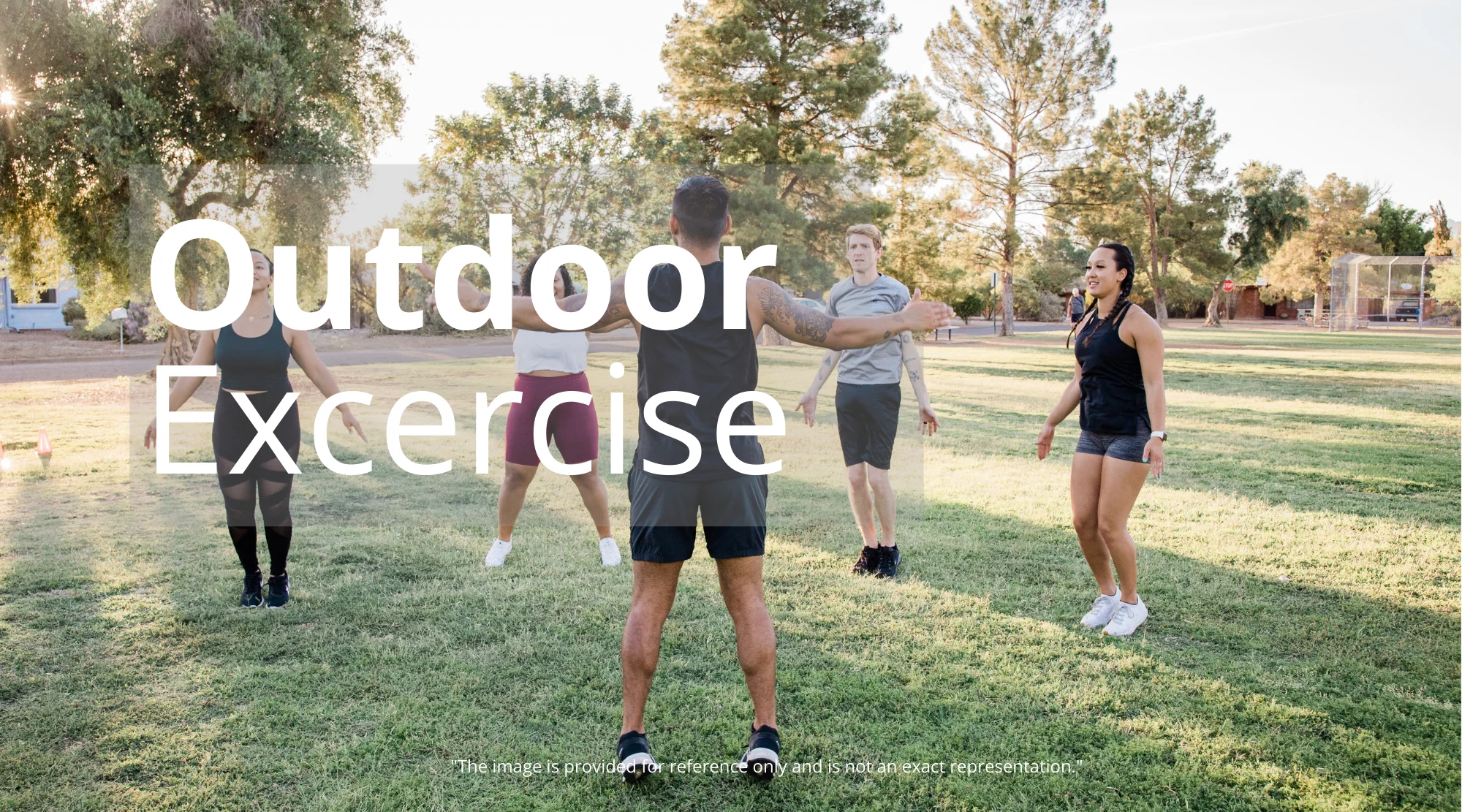Harnessing Nature’s Power: Unveiling the Remarkable Benefits of Outdoor Exercise
Are you seeking a transformative approach to enhance your physical and mental well-being? Discover the unparalleled advantages of embracing outdoor exercise. Beyond the typical gym setting, the natural world offers a unique synergy that can significantly boost your health. This comprehensive guide delves into the scientifically-backed benefits of exercising outdoors, revealing how sunlight, fresh air, and natural surroundings can elevate your fitness journey and overall quality of life.

The Symphony of Nature and Fitness: Why Outdoor Exercise Excels
Outdoor exercise transcends the limitations of indoor workouts, offering a comprehensive approach to wellness. It’s not just about the physical activity; it’s about immersing yourself in an environment that naturally promotes health and vitality. Let’s explore the key elements that make outdoor exercise so potent:
The Power of Sunlight and Vitamin D
One of the most significant advantages of outdoor exercise is exposure to sunlight. This natural resource plays a crucial role in vitamin D production, a vital nutrient for various bodily functions. Vitamin D is essential for:
- Boosting the Immune System: It helps regulate the immune response, making your body more resilient to illnesses.
- Strengthening Bones: Vitamin D facilitates calcium absorption, promoting strong and healthy bones.
- Elevating Mood: Studies suggest a link between vitamin D and improved mood, potentially mitigating symptoms of depression.
Engaging in outdoor activities, like walking, jogging, or cycling, allows your body to synthesize vitamin D naturally. This process is far more efficient than relying solely on supplements, as the body can regulate its production based on its needs.
Breathe Easy: The Advantages of Fresh Air
Fresh air is another major component of the advantages of outdoor exercise. The air in outdoor settings often contains a higher concentration of oxygen and fewer pollutants compared to indoor environments. Breathing fresh air can lead to:
- Improved Lung Function: Oxygen-rich air allows for more efficient oxygen uptake, enhancing lung capacity and overall respiratory health.
- Reduced Stress: Being in nature can lower stress hormones and create a sense of calm, promoting relaxation.
- Enhanced Energy Levels: Proper oxygenation fuels your muscles and brain, leading to increased energy and reduced fatigue.
The Therapeutic Touch of Nature
The natural environment itself offers a range of therapeutic benefits. Studies show that spending time in nature can reduce stress, lower blood pressure, and improve mental clarity. The calming effect of natural surroundings contributes to:
- Reduced Anxiety and Depression: The beauty of nature has a soothing impact on the nervous system, reducing symptoms of anxiety and depression.
- Improved Focus and Concentration: Being in a natural environment can help to restore your attention span, and reduce mental fatigue.
- Enhanced Creativity and Problem-Solving: Exposure to nature can stimulate creativity and promote innovative thinking.
Unpacking the Physical Benefits: How Outdoor Workouts Shape Your Body
The advantages of outdoor exercise extend beyond mental well-being. The physical demands and environmental factors involved in outdoor activities can lead to a more comprehensive and effective workout.
Enhanced Cardiovascular Health
Any form of exercise benefits cardiovascular health, but outdoor workouts add an extra layer of effectiveness. The varied terrain and dynamic conditions of outdoor settings can:
- Increase Calorie Burn: Uneven surfaces and inclines make your body work harder, leading to a higher calorie expenditure.
- Improve Cardiovascular Endurance: Activities like hiking and running outdoors challenge your cardiovascular system in ways that are more varied than a treadmill.
- Boost Heart Rate Variability: Exposure to natural environments can positively impact your heart rate variability, a marker of overall health and resilience.
Strengthened Muscles and Bones
Outdoor activities often involve a wider range of movements and challenges compared to indoor exercises. This can lead to:
- Increased Muscle Activation: Navigating diverse terrains and performing bodyweight exercises outdoors engages a broader spectrum of muscles.
- Improved Bone Density: Weight-bearing activities like running and hiking can help to strengthen bones, reducing the risk of osteoporosis.
- Enhanced Balance and Coordination: Outdoor environments often require you to adapt to changing surfaces, improving your balance and coordination.
Adaptability and Functional Fitness
Outdoor exercise promotes functional fitness, which involves training your body to perform real-world movements. This can translate to:
- Improved Athletic Performance: Whether you’re a seasoned athlete or a weekend warrior, outdoor training can boost your overall athleticism.
- Reduced Risk of Injury: Functional movements help strengthen muscles and joints, making your body more resilient to everyday activities.
- Increased Mobility and Flexibility: Activities like hiking and climbing can improve your range of motion and overall flexibility.
Elevating Your Mental Game: How Outdoor Exercise Transforms Your Mind
The advantages of outdoor exercise are inextricably linked to improved mental well-being. The natural environment provides a unique setting to reduce stress, boost mood, and enhance cognitive function.
The Stress-Reducing Effects of Nature
Chronic stress can have a detrimental impact on physical and mental health. Outdoor exercise provides a powerful antidote, with benefits like:
- Lowering Cortisol Levels: Studies show that spending time in nature reduces levels of the stress hormone cortisol.
- Promoting Relaxation: The sensory experiences of being outdoors – the sounds of birds, the smell of fresh air – can induce a state of relaxation.
- Improving Sleep Quality: Regular outdoor exercise can help regulate your circadian rhythm, leading to improved sleep. If you are looking to improve your sleep quality, you can check out this article on Weighted Blankets: Unveiling the Benefits for Anxiety Relief, Sleep, and Relaxation.
Mood Enhancement and Emotional Balance
The positive effects of outdoor exercise can be profound for your mood and emotional well-being:
- Boosting Serotonin and Dopamine: Sunlight exposure and physical activity stimulate the release of neurotransmitters like serotonin and dopamine, which are associated with feelings of happiness and well-being.
- Reducing Symptoms of Depression: Numerous studies have demonstrated the effectiveness of outdoor exercise in alleviating symptoms of depression. You might also find the information in this article on Keto Diet for Depression: Can Ketogenic Eating Improve Your Mental Health? relevant.
- Enhancing Self-Esteem: Achieving fitness goals outdoors can boost self-confidence and self-esteem.
Cognitive Enhancement and Mental Clarity
Outdoor exercise can sharpen your mind and improve cognitive performance:
- Improving Focus and Concentration: Being in a natural environment reduces mental fatigue, allowing for improved focus and concentration.
- Enhancing Memory and Learning: Studies have shown that outdoor exercise can enhance memory and learning abilities. Consider reading this article on 40 Minutes of Exercise: The Secret to Boosting Brain Health & Memory (Backed by Science) to find out how much exercise you need.
- Boosting Creativity and Problem-Solving Skills: Exposure to natural settings can stimulate creativity and promote innovative thinking.
Crafting Your Outdoor Fitness Routine: Tips and Considerations
To maximize the advantages of outdoor exercise, consider these practical tips and precautions:
Selecting the Right Activity
Choose activities that match your fitness level, preferences, and the environment:
- Walking and Jogging: Suitable for all fitness levels, providing a low-impact way to improve cardiovascular health.
- Hiking: A challenging and rewarding activity that combines exercise with nature exploration.
- Cycling: A great way to enjoy the outdoors while getting a cardiovascular workout.
- Bodyweight Exercises: Utilize parks or outdoor spaces for exercises like push-ups, squats, and planks. You could check out this article on Roxanne Push-Up Challenge: Unleash Your Fitness with This Fun Workout!
- Yoga and Pilates: Practice these disciplines in a park or on a beach to enhance flexibility and mindfulness. Consider this article on Boost Spinal Mobility: 3 Yoga Poses for Flexibility and Health for more information.
Safety First: Precautions and Tips
Prioritize your safety when exercising outdoors:
- Stay Hydrated: Drink plenty of water before, during, and after your workouts. This article on Hydration & Stress: The Surprising Link That Can Change Your Life explains the link between hydration and stress.
- Wear Appropriate Clothing: Dress in layers to adapt to changing weather conditions.
- Apply Sunscreen: Protect your skin from harmful UV rays.
- Be Aware of Your Surroundings: Pay attention to traffic, wildlife, and other potential hazards.
- Listen to Your Body: Rest when you need to and don’t push yourself too hard, especially when starting a new routine.
Maximizing the Benefits: Strategic Planning
Enhance your outdoor exercise experience with strategic planning:
- Vary Your Workouts: Rotate between different activities to keep your routine interesting and challenge your body in new ways. You could consult Best Exercises for Seniors: Stay Active and Thrive After 60 if you are in this age range.
- Set Realistic Goals: Start slowly and gradually increase the intensity and duration of your workouts.
- Find a Buddy: Exercising with a friend can provide motivation and accountability.
- Explore New Locations: Discover new parks, trails, and outdoor spaces to keep your workouts fresh and exciting. If you are looking for some great places for a vacation, you could check out the article Top 10 Destinations for a Happy Vacation: Boost Your Well-being in 2024 to find out the top destinations.
Overcoming Obstacles: Making Outdoor Exercise Accessible
Several barriers can prevent people from embracing outdoor exercise. Overcoming these obstacles requires a bit of creativity and adaptability.
Weather-Related Challenges
- Seasonal Adjustments: Adapt your routine based on the season. In the winter, consider cross-country skiing or snowshoeing. In the summer, exercise during cooler parts of the day, such as early mornings or late evenings.
- Indoor Alternatives: Have backup indoor options on rainy or extreme weather days. Try using a treadmill, doing bodyweight exercises, or following online workout videos.
Time Constraints
- Short Bursts: Even a 15-20 minute outdoor walk can provide significant benefits. Consider incorporating short bursts of activity into your daily routine, such as walking during your lunch break or after dinner. Consider the option of taking Active Breaks at Work: Prevent Injuries and Boost Productivity (The Complete Guide) to boost your work productivity.
- Weekend Activities: Utilize weekends to enjoy longer outdoor activities like hiking or cycling.
Accessibility Issues
- Urban Exploration: Find green spaces within your city, such as parks or greenways.
- Community Resources: Explore local recreational centers, community sports groups, or walking clubs.
Integration and Consistency: Making Outdoor Exercise a Lifestyle
The key to reaping the long-term benefits of outdoor exercise is to integrate it into your lifestyle and practice consistency.
Building Habits
- Schedule It: Treat outdoor exercise like any other important appointment in your calendar.
- Pair It: Combine it with other activities you enjoy, like listening to a podcast or meeting a friend.
- Reward Yourself: Celebrate your progress with small rewards to maintain motivation.
Finding Your Motivation
- Set Realistic Goals: Define specific, measurable, achievable, relevant, and time-bound (SMART) goals to track your progress.
- Find Activities You Enjoy: Choose activities you find pleasurable to enhance enjoyment and adherence.
- Track Your Progress: Use fitness trackers, apps, or journals to monitor your workouts and accomplishments.
The Path to Long-Term Health
- Make It a Ritual: View outdoor exercise as an integral part of your daily or weekly routine.
- Embrace the Journey: Focus on the process and the enjoyment of being in nature, not just the results.
- Listen to Your Body: Pay attention to your body’s signals and adjust your routine accordingly.
Conclusion: Embrace the Outdoors and Thrive
The advantages of outdoor exercise are undeniable. From bolstering your physical health to enhancing your mental well-being, the natural world offers a holistic approach to fitness that surpasses the limitations of indoor settings. By embracing the sun, fresh air, and diverse environments of the outdoors, you can unlock a new level of health and vitality. Take the first step today: venture outside, breathe deeply, and experience the transformative power of nature in motion. You can also read this article on [Healthy Aging: Proven Strategies for a Vibrant and Fulfilling Life]












4 comments